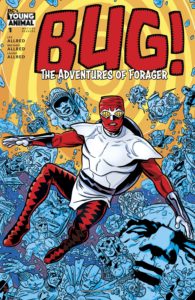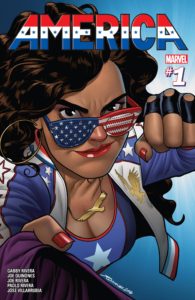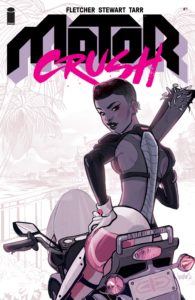Hello there, I’m back! Much has happened since 2012, the last time I inflicted my opinions on all things comics-ish on you, gentle readers. I’d bet that there aren’t even that many of you left who remember my old column! I won’t go into my reasons for my absence because they’re boring and you don’t care, really… suffice it to say that I have the itch again (even though, to be honest, my comics consumption has really slowed down in the last few years- I still do keep up with what’s current though) and I will be back here once a month to let you know what I thought about what I read, and hopefully steer you towards the good stuff when possible.
 BUG! The Adventures of Forager #’s 1, 2
BUG! The Adventures of Forager #’s 1, 2
Lee Allred, script, Michael Allred, script/art, Laura Allred, colors
DC/Young Animal, ongoing, $3.99
Jack Kirby left such a great legacy and so many imaginative, memorable characters, that it’s no surprise that DC (they have all those IP’s to exploit, you know- thanks, Jack) and so many creators (who quite rightly want to pay tribute to the man that inspired so many) want to continue to play in that sandbox. The latest is none other than Mike Allred, once of Madman fame and who has gone on to play in numerous sandboxes of both companies (I recall that he has a recent well-received stint on Silver Surfer to his credit, among others, I haven’t read it) with varying degrees of success. The twist here is that it’s truly an Allred family affair this time; brother Lee is co-credited on script and spouse Laura does her usual great job on colors. All in service of DC’s newish “Young Animal” imprint, designed to provide the same kind of vibe that Vertigo provided, but apparently in a super-hero friendly fashion, since many of the titles launched under that imprint (Doom Patrol, Shade the Changing Girl, Cave Carson Has a Cybernetic Eye) feature repurposed DC characters of varying pedigrees.
Bug! gives us a fairly minor character in that vast tapestry that was Kirby’s Fourth World books (New Gods, Forever People, Mister Miracle and Jimmy Olsen), a young fellow named “Forager” who was part of the New Genesis (the presumed “good guys”, certainly preferable to Darkseid’s Apokolips) faceless worker caste, who were treated, truth be told, rather badly by the ruling caste that Highfather, Orion, Lightray, etc. represented. Certainly Kirby intended to provide a little social commentary in this fashion, but alas New Gods got cancelled only two issues after Forager was introduced in #9. If you’re not familiar with Kirby’s Fourth World, the Wikipedia entry here explains it as well as anything. It’s a long and gnarly history, believe me.
40 years later, the pop-culture savvy Mike Allred of course would gravitate to a character like Forager, who really hasn’t been used enough to accumulate a lot of continuity barnacles. Allred’s art has always reminded me of Kirby as well (inked by Chic Stone, my fave Kirby inker), so it’s usually always worth a look when he takes on one of the King’s concepts. The Bug is drawn as one of Allred’s usual long-haired young rebel types, bearing a little resemblance to what I remember Paul Pope looking like once upon a time… storywise, he and brother Mike have concocted an odd sort of surreal framework here; he awakes from death (something which is alluded to in a flashback, I must have missed that comic) to encounter at first a weird ghost girl who has a talking teddy bear and a fascination with dominoes. Things get even stranger when this is revealed to be the dream domain of the 3rd iteration of the Sandman (who was thoroughly deconstructed in Neil Gaiman’s Sandman, but I’m sure that’s all been retconned since then and it was original Vertigo anyway, so they may just say it doesn’t count), done of course by Kirby in the 70s, who is tasked with protecting the real world against menaces from the Dream Dimension. A bad guy named “General Electric”, that’s right, gets involved, seeking to steal an metal with magical properties from the Sandman, and comes into conflict with our Bug as well. #2 finds this conflict resulting in Bug going back in time to WWII and encountering the second Sandman, the Simon/Kirby yellow/purple supersuited action hero and his sidekick Sandy, the original Blue Beetle, and the WWII era Losers, battling Yetis and General E again in Tibet.
As you can probably tell by now, this is all very inside baseball and is crammed full of references to all kinds of comics history gone by, both arcane and common. It reminds me a lot of Mike’s signature work Madman, which also features a resurrected young wannabe rebel protagonist who is seeking answers about the who, what, where, and why of his life and encounters all kinds of weirdness as he quests. There’s no shortage of quirk; to name one example, General E has a battalion of robot soldiers with electrical plugs on their heads for no real discernible reason except to reinforce the GE pun and perhaps make a sort of anti-big business joke. Bug! is fast paced, and Mike’s art is as solid as always; his style isn’t flashy or as quirky (given what goes on in the script) as you’d expect, but his visuals are always clear and well-thought-out. The dialogue doesn’t work as well; for every clever pun or reference there are two that kinda just lay there flat. I’m not exactly sure what kind of audience this hopes to attract; younger readers might be receptive to the tone but find all the constant in-jokes and callbacks confusing; and I’d imagine the aging fanboys who once loved Kirby’s originals will just be confused or unimpressed. I hope the Allreds can take what seems to be a “monthly guest star(s)” format title in some sort of direction that can transcend all that. We’ll see.
 America #’s 1-3
America #’s 1-3
Script: Gabby Rivera; Art: Joe Quinones, Joe Rivera, various collaborators.
Marvel Comics, ongoing series, $3.99
The “America” in question this time out isn’t Captain, or even the country, but America Chavez, a character who’s been around quite a while already in many recent-ish Marvel series, most notably the Young Avengers of Kieron Gillen and Jamie McKelvie’s run. She’s a queer Latina Wonder Woman-ish type; super strong and super smart, and more cynically, she’s keeping the “Miss America” character Marvel has had since the 40s’ license in perpetuity. I’ll give Marvel all the credit in the world for its diversification initiative; there’s a certain element that hates seeing an African-American Spider-Man or a female Thor, but I think in year 2017, what with everything that’s been done to all these characters in the last 50 years, it’s a misguided complaint at best. Anyway, I digress.
Now that the character has her own series, it finds her breaking away from the super-teams and allies from previous stories (although, yes, there are many callbacks to all of them) and breaking up with her current girlfriend, then enrolling in college, which leads to a rather gnarly-plotted time-traveling multi-dimensional story arc that, to be honest, left me confused more often as not. Artwise, it’s capably drawn by Joe Quinones with a number of guest pencillers (including Ming Doyle) contributing and a host of inkers, most prominently Joe Rivera- you’d think this would lead to visual chaos but surprisingly the style is quite consistent- solid but the collective doesn’t really have a distinctive style between them, surprising because I’ve seen much better from all of the separate components. Perhaps they’re trying to emulate the static stylings of longtime Young Avengers (and current Wicked + the Divine) artist McKelvie, who has done the character a lot, I don’t know. This is not a knock, necessarily; they tell the story well enough but it’s just hard to get excited by it.
I have liked America a lot when she’s appeared in other titles; she’s a confident, no-nonsense problem-solver type who plays well with others. So far, in her own book, though, the scripting suffers just a bit from an unusual problem- it’s written in the same (here’s this word again, and I’m sorry for the repetition) quirky, jokey, self-aware, metatextual style that starts out as fun but soon wears itself out; it reads much like other Marvel titles of this type such as The Unbeatable Squirrel Girl and Patsy Walker AKA Hellcat!, lighthearted and fun, yet the fun seems to take over and leaves the reader with nothing really to invest themselves in. If I know that Squirrel Girl will overcome these difficulties to win every single time with no character development whatsoever, it becomes a rather routine read, which is why I quite buying SG after a healthy 18 or so issue period. The quirk just overwhelmed everything else. America is not quite at this stage yet, but the tone is similar. It’s also similar in a lot of ways to Charles Soule’s excellent take on She-Hulk a couple of years ago; it had its share of jokiness but also kept things down to earth in its character interaction which balances things out. Perhaps it’s just a matter of me not being the target audience, which I’d imagine skews younger than yr humble scribe. If I like a character enough, I’ll stick with it through a lot, and that’s gonna keep me reading America for a while longer… your mileage, as they say, may vary.
 Motor Crush TPB
Motor Crush TPB
Story: Babs Tarr, Brenden Fletcher, Cameron Stewart
Art: Babs Tarr, Cameron Stewart
Image Comics, $9.99
Tarr/Fletcher/Stewart were the creative team behind one of DC’s umpteen attempts to do Batgirl; they provided a fresh, fun take that didn’t last nearly as long as it should before the constantly rebooting publisher decided yet another direction was in order. Don’t know all the whys and wherefores of that decision, but the team quickly launched Motor Crush not long after, and it has many of the charms of their work with Babs Gordon’s alter-ego. In fact, as I recall, their Batgirl run at one point featured a duo of not-so-nice young ladies who went around on motorcycles and created havoc before Batgirl shut them down; can’t help but think those characters were the inspiration for all this, or perhaps Tarr and Stewart just like manga-esque motorbike action, who knows.
Another inspiration, I dare say, is Speed Racer– and that is basically what we have here, except it’s genderswitched and Speed in this case is addicted since birth to “Crush”, which (if I understand it) not only stimulates and imparts extraordinary abilities to people- it’s such potent speed that it even affects time itself, or at least perception of it, enabling the user to do Flash-type stunts- but also it’s intended to act like a super-fuel for the motorbikes that are all-important to seemingly everyone in this future society the creators have dreamed up. Our heroine is Domino Swift, known as “Cricket” to the other racers; she races by day for her Dad, who, like Pops Racer, is a race mechanic of renown, and by night in Running Man- style illegal-yet-televised races in which the prize is a stock of Crush, which our girl needs to survive. There’s a lot of mystery in her past; she’s adopted, you see, was addicted to the stuff from birth (as I stated previously), and of course there are all kinds of enigmatic allusions about who she really is and where she came from, and Pops doesn’t want her to know. Aggravating all this is a Racer X type who, by the end of this collection, has already talked to Domino and has given her the purest Crush she’s ever had, telling her that she is more than she seems. This will, of course, all be revealed eventually, I have no doubt. It’s harsh and not entirely accurate to call this an “idiot plot“, but I can’t help but think that a lot of the drama these characters have going on could be avoided by just letting them talk to each other, and tell each other plainly what’s going on. Ah, but then we wouldn’t have a multi-issue story arc, would we?
I do like the artwork this team creates; of course, it’s very manga/anime-beholden, as it seems 8.5 out of every 10 young artists are, but it adapts that style in an exciting fashion. Tarr and Stewart (a very good artist in his own right, not especially manga-influenced) work well together. I’m sure at some point since Batgirl I was made aware of how their collaboration works; the one perhaps does layouts and the latter finishes, but don’t quote me on that. Regardless, they do turn out a very bracing type of illustration work- fast paced and expressive, and with appealing character design. Sometimes it can get a little sketchy and crude, usually when the action ramps up so I have to assume that’s a creative decision, but overall it works very well with the subject matter.
Some may find Motor Crush a bit derivative- honestly, I haven’t read much, if anything, about critic or reader reactions to the series. That said, it’s always been my belief that derivative isn’t necessarily a bad thing if the people who are doing the borrowing have the skills to make something good out of it, and after the five issues I’ve read, I believe that this applies to Fletcher/Stewart/Tarr and company. I think you should check it out for yourself.
OK, that will do for this month- thanks for reading, and look for my second Nobody’s Favorite Record Review next month.





Comments